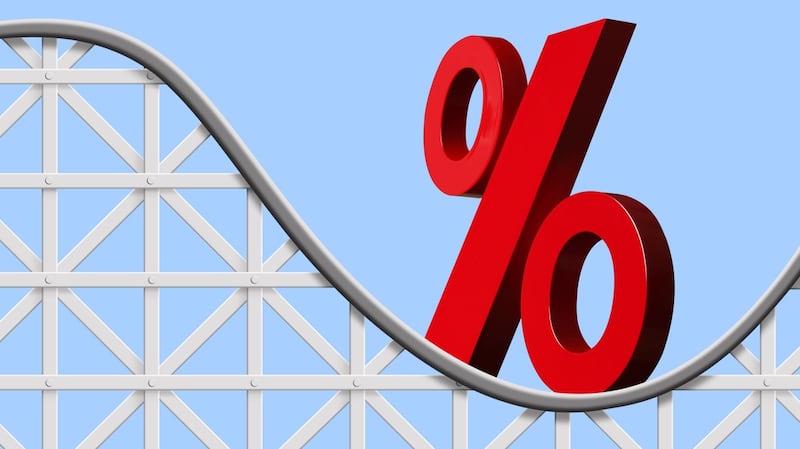It has been coming for a while. But this week we see clear evidence that the interest rate cycle has turned.
The Bank of England has increased interest rates and the US Federal Reserve Board now says it sees three rate increases as likely next year. The European Central Bank (ECB) is moving more slowly, but will wind down its emergency programme of support for Government borrowing and could come under pressure to start pushing up interest rates before the end of 2022.
It all comes from the surprisingly sharp jump in the rate of inflation – and how this pans out in 2022 will be key to determining what happens next.
And as well as implications for borrowers and governments, a sustained rise in interest rates would slowly start to alter an equation which has driven world markets and investment flows in recent years – a search for yield because cash in the bank was paying no interest. This, too, could be vital for Ireland.
1. Inflation is back
Since the financial crash after 2008, inflation internationally remained low. This continued a trend seen since the 1980s; since then lower inflation has led interest rate cycles to peak at lower and lower levels, driven by globalisation pushing down costs and an ageing population.
After the financial crisis, interest rates remained low across major economies and the pandemic led to a major monetary expansion as central banks stepped in to buy huge amounts of Government bonds, effectively financing a massive programme of Government spending.
But in recent months the rise in the rate of inflation has taken forecasters by surprise. There was always going to be a once-off bounceback in areas like energy prices, which collapsed as the pandemic hit. But energy costs have continued to rise, problems in supply chains have fed through to prices and the supply of goods has not been able to keep up with the surge in demand as economies reopened. Rising wages are resulting from labour shortages.

This has led to a string of high inflation readings – US inflation has soared to 6.8 per cent, the highest in 40 years and euro zone inflation was at a record 4.9 per cent in November. Ireland’s November rate was 5.4 per cent, the highest in more than two decades.
There are once-off factors at play here, as identified in a Department of Finance paper this week.
Part of the increase is so-called base effects – comparing prices this year to unnaturally low prices last year in areas like energy and airfares.
Part of it relates to supply chain problems related to the impact of Covid-19; shortages in key areas like semiconductors have had big impact on the car market.
Central banks had expected inflation to ease more quickly – and still expect it to do so next year.
The base effects will drop off, supply chains should repair and consumer demand should be steadier. But, as the department paper says, there is a risk that higher prices now feed into a more sustained rise in wages and inflationary pressures.
The impact of Omicron is uncertain – it could reduce demand, particularly for services, but also again put pressure on supply chains.
The department warns that a budget forecast of a headline inflation rate in Ireland of 2.5 per cent could be exceeded, with a 3 per cent avearge rate for 2022 a possibility and inflation set to peak at much higher levels before that.
2. Central banks respond
The big central banks have all announced policy changes in response to the inflationary trends. With UK inflation now forecast to head to 6 per cent next year, the Bank of England is ahead of the rest on tightening policy.
Ignoring the threat of Omicron, it has increased its key interest rates from 0.1 per cent to 0.25 per cent and says further “modest” increases are likely to be needed. It is winding down its bond buying programme at the end of this year.
In the US, the Federal Reserve Board is to wind down its buying of US government debt by next March and its governors expect three interest rate hikes later next year and another two in 2023.
The key US Fed rate is currently set at just over 0 per cent. Fed chair Jay Powell referred in particular to inflationary pressures from the jobs market.
The ECB is moving more cautiously, amid signs of a debate on its governing council.
It confirmed it planned to end its emergency buying of government bonds in March under the pandemic programme, but would increase purchases at a lower level under an older programme.
So it will effectively gradually withdraw support for Government borrowing – which has amounted to €90 billion in purchases a month on average in 2021 – though it did leave open the option of upping its purchase plans if conditions worsened.
3. Will interest rates rise by much?
A key issue for investors and borrowers worldwide is how far interest rates might rise in this next upward cycle. Are we just looking at a gentle rise?
Fed officials forecast that the key US rate might rise to 2.1 per cent by 2024, and current market expectations are that it might rise to just 1.5 per cent. In the UK, the Bank of England has referred to further “modest” interest rate increases as being likely in 2022 to control inflation.
For the ECB, the question is whether is may come under pressure in 2022 to increase its deposit rate – the rate it pays banks for overnight funds – which is currently at minus 0.5 per cent. An increase in its main rate – the refinancing rate currently at 0 per cent – would likely only follow at a later stage.
As of now markets are not expecting that the ECB will push up interest rates a few times next year like the Bank of England or the Fed. But the inflationary trend is now unpredictable and all of the big central banks will have to respond to whatever happens.
As this develops the appropriate role of central banks will be an issue for debate; during the pandemic central banks supported government borrowing and an expansionary policy.
Some economists argue that they should not return to their old role as “party poopers” trying to slow growth and control inflation – and withdrawing stimulus could upset markets as well. But the message from central banks this week is that policy is tightening because of higher inflation – and that Governments will have to get used to it.
4. What does it mean for Ireland?
For the Government, borrowing costs were low even before the pandemic and fell further during it. These are likely to edge higher as ECB support is withdrawn. And investors will now be more carefully assessing the finances of countries to which they lend as they will no longer have a ready buyer for Government debt in the shape of the central bank.
The Government will hope that bond interest rates remain low – and it helps that the deficit and thus the need for Government borrowing is falling more quickly than anticipated.
However looking a few years out, when pandemic borrowings come to be refinanced, the risks have certainly now increased. The current ability to borrow unlimited amounts at zero interest rates will slowly draw to a close.

Mortgage borrowers will also be watching closely. In an analysis for Bespoke Estate Agents, economist Dr Dan McLaughlin points out that the impact off higher rates would be a bit less now than in the past, with half of borrowers on fixed rates and one third on tracker rates, currently average just over 1 per cent. Tracker rates are tied to the ECB refinancing rate and thus will not increase if the central bank pushes up its deposit rate later next year or early in 2023.
However this move could feed through into higher variable rate offers for new borrowers, McLaughlin says, and – if markets expect a longer-term rise in borrowing costs – into higher fixed rate offers. Trackers would rise in time as the ECB increased its refinancing rate.
For now financial markets expect any ECB rise to be gradual and moderate; they believe that the ECB is correct that inflationary pressures, while rising in spring, will be a lot less by the end of the year. But we have seen with the US central bank how quickly expectations could change – so we will just have to wait and see.
As with the State, mortgage borrowers will hope increases over the next two to three years are moderate.
The end of the era of free money also promises a fundamental change in financial markets.
Money has poured into Ireland from overseas – into property, financial markets, bonds and so – because investors have no other options. Its is called the Tina trade – there is no alternative.
Now, as rates start to edge up, higher returns will start to become available from some safer haven investments, even if these will struggle to keep up with inflation. A big change is coming, even if we are not sure exactly what it will look like. The cycle has turned.












